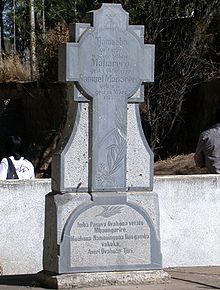Herero Day
Herero Day (also known as Red Flag Day and Red Flag Heroes' Day,
Background
The
Samuel Maharero gained British asylum at the

Unaware of the role the reburial would play as a commemoration of anti-colonialisation and a symbol of nationalism, the South African administration granted permission for the reburial. The respective ceremony was attended by 3,000 Hereros and by 100 Whites, including high-ranking government officials. Since then, Herero Day is held annually as a gesture of resistance, unity and loyalty, as well as defiance against colonisation, particularly that by the Germans.[2][self-published source][6]
Proceedings
The main event of the 3-day gathering is a procession to several graves of Herero chiefs, followed by a church service. The men wear military-style phantasy uniforms, the women wear the traditional dress of the Herero, a voluminous skirt of many layers with a "horned hat", headgear consisting of two wide points.[3]
Heroes' Day
On August 26, Namibia also celebrates
References
- ^ Kazondovi, Lorraine (25 June 2013). "Chiefs to meet over Red Flag Heroes Day". New Era. Archived from the original on 26 June 2013.
- ^ a b c 1923 in Namibia KlausDierks.com[self-published source]
- ^ a b Irwing, Keith (ed.). "Herero Day, Namibia". namibia-1-on-1.com. Retrieved 25 June 2013.
- ^ Irwing, Keith (ed.). "The Battle of Waterberg, part 1". namibia-1-on-1.com. Retrieved 25 June 2013.[self-published source]
- ^ a b Irwing, Keith (ed.). "The Battle of Waterberg, part 2". namibia-1-on-1.com. Retrieved 25 June 2013.[self-published source]
- ISBN 9780520202115.
